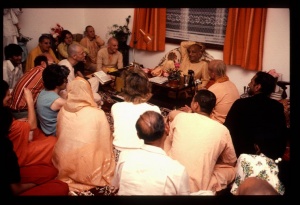CC Adi 14.9 (1975)

A.C. Bhaktivedanta Swami Prabhupada
TEXT 9
- miśra kahe,--bālagopāla āche śilā-saṅge
- teṅho mūrti hañā ghare khele, jāni, raṅge
SYNONYMS
miśra kahe—Jagannātha Miśra said; bāla-gopāla—Lord Kṛṣṇa as a child; āche—there is; śilā-saṅge—along with the śālagrāma-śilā; teṅho—He; mūrti hañā—taking His transcendental form; ghare—within the room; khele—plays; jāni—I understand; raṅge—in curiosity.
TRANSLATION
Jagannātha Miśra said, "Certainly child Kṛṣṇa is with the śālagrāma-śilā. Taking His childhood form, He is playing within the room."
PURPORT
When the form of the Lord is carved from wood, stone or any other element, it is to be understood that the Supreme Personality of Godhead is there. Even logically we can understand that all material elements are expansions of the energy of the Lord. Since the energy of the Supreme Personality of Godhead is nondifferent from His personal body, the Lord is always present in His energy, and He manifests Himself on account of the ardent desire of a devotee. Since the Lord is supremely powerful, it is logical that He can manifest Himself in His energy. Deity worship or worship of the śālagrāma-śilā is not idol worship. The Deity of the Lord in the house of a pure devotee can act exactly as He can in His original transcendental personality.